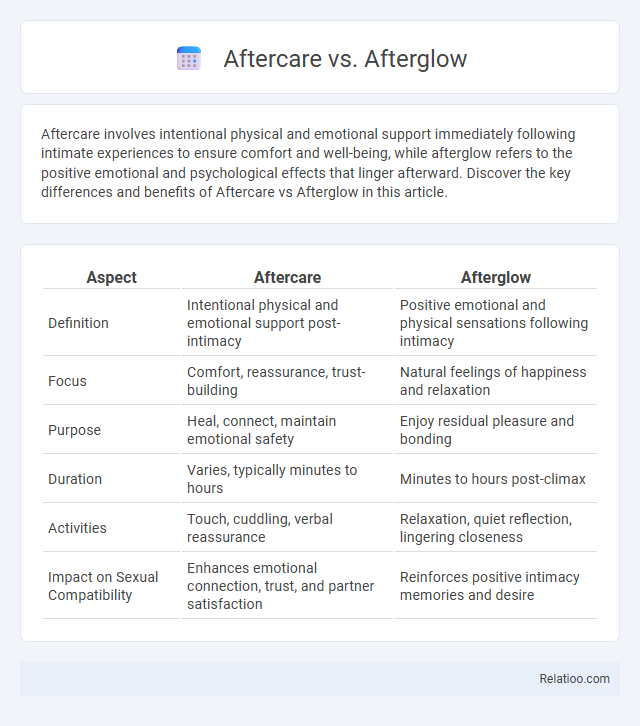Aftercare involves intentional physical and emotional support immediately following intimate experiences to ensure comfort and well-being, while afterglow refers to the positive emotional and psychological effects that linger afterward. Discover the key differences and benefits of Aftercare vs Afterglow in this article.
Table of Comparison
| Aspect | Aftercare | Afterglow |
|---|---|---|
| Definition | Intentional physical and emotional support post-intimacy | Positive emotional and physical sensations following intimacy |
| Focus | Comfort, reassurance, trust-building | Natural feelings of happiness and relaxation |
| Purpose | Heal, connect, maintain emotional safety | Enjoy residual pleasure and bonding |
| Duration | Varies, typically minutes to hours | Minutes to hours post-climax |
| Activities | Touch, cuddling, verbal reassurance | Relaxation, quiet reflection, lingering closeness |
| Impact on Sexual Compatibility | Enhances emotional connection, trust, and partner satisfaction | Reinforces positive intimacy memories and desire |
Understanding Aftercare and Afterglow
Aftercare involves the intentional physical and emotional support provided immediately following an intense experience, such as a medical procedure or intimate encounter, to promote healing and comfort. Afterglow refers to the lingering positive feelings and sense of well-being that persist after the initial experience, enhancing Your overall mood and mental state. Understanding the distinction between aftercare and afterglow ensures you prioritize both immediate recovery and the continued emotional benefits that follow.
Defining Aftercare: What It Really Means
Aftercare is the essential practice of providing physical, emotional, and psychological support following an intense experience, ensuring your well-being and recovery. Unlike afterglow, which refers to the lingering positive feelings or mood after such events, aftercare involves proactive steps like hydration, rest, and communication to address any discomfort or vulnerability. Understanding aftercare's true meaning emphasizes its role in maintaining health and fostering trust, making it a crucial component of any meaningful interaction or experience.
What Is Afterglow? Key Characteristics Explained
Afterglow refers to the positive emotional and physical sensations experienced after intense moments, such as intimacy or deep connection, characterized by feelings of warmth, closeness, and contentment. Key characteristics of afterglow include a sustained release of endorphins and oxytocin, promoting relaxation and bonding. Unlike aftercare, which involves deliberate soothing actions to support recovery, afterglow is a natural, spontaneous state reflecting post-experience well-being.
Why Aftercare Matters in Relationships
Aftercare in relationships involves intentional support and emotional reassurance following intimate or vulnerable experiences, fostering trust and deepening connection. Afterglow refers to the positive feelings that linger after intimacy, while aftercare actively addresses your emotional and physical well-being to prevent misunderstanding or discomfort. Prioritizing aftercare promotes healthy communication, emotional safety, and strengthens the bond between partners.
The Psychological Impact of Aftercare
The psychological impact of aftercare is crucial for emotional recovery, providing comfort and reassurance that helps mitigate trauma or distress experienced during intense interactions. Afterglow, characterized by a period of relaxation and emotional bonding, supports mental well-being by releasing oxytocin, which fosters a sense of safety and connection. Proper aftercare practices can enhance trust and reduce anxiety, making it an essential component for maintaining healthy psychological states post-experience.
The Emotional Benefits of Afterglow
Afterglow refers to the positive emotional state experienced after an intimate or meaningful moment, characterized by feelings of satisfaction, closeness, and calm. Unlike aftercare, which involves active physical and emotional support following intense experiences, afterglow is a spontaneous emotional benefit that enhances your overall sense of well-being and connection. Recognizing and valuing your afterglow can deepen relationships by fostering emotional intimacy and resilience.
Aftercare vs Afterglow: Key Differences
Aftercare and afterglow differ primarily in their focus and timing; aftercare involves intentional physical and emotional support immediately following an intense experience or activity, while afterglow refers to the lingering positive feelings and mental state that persist afterward. Aftercare typically includes actions like hydration, rest, communication, and comfort to facilitate recovery, whereas afterglow is characterized by a sustained sense of well-being and contentment without active intervention. Understanding these distinctions helps optimize recovery processes and maximize the benefits of any intense or transformative experience.
Integrating Aftercare and Afterglow for Deeper Bonds
Integrating aftercare and afterglow practices enhances emotional connection and physical well-being after intimate experiences, deepening trust and communication between partners. Aftercare involves intentional nurturing activities such as gentle touch, verbal reassurance, and hydration to support recovery and comfort, while afterglow refers to the prolonged positive feelings and emotional warmth following intimacy. Combining these elements cultivates a holistic approach that strengthens bonds, promotes mutual understanding, and reinforces long-lasting relational satisfaction.
Common Myths About Aftercare and Afterglow
Aftercare and afterglow are often misunderstood, as common myths suggest they are interchangeable terms when they refer to different recovery phases; aftercare involves physical and emotional support immediately following intense experiences, while afterglow describes the residual positive feelings that linger afterward. Many believe aftercare is solely physical, but it includes emotional comfort and mental reassurance vital for holistic well-being. Misconceptions about afterglow being a permanent state overlook its temporary nature as the body and mind gradually return to baseline after significant stress or stimulation.
Tips for Enhancing Aftercare and Afterglow Experiences
Aftercare and afterglow are essential components of a fulfilling intimate experience, with aftercare focusing on physical and emotional support immediately following intimacy, and afterglow describing the lingering positive feelings afterward. To enhance your aftercare, prioritize open communication, gentle touch, and hydration to support recovery and emotional connection. For a lasting afterglow, create a calm environment with soothing scents, soft lighting, and deep relaxation techniques that encourage your body and mind to fully absorb the shared experience.

Infographic: Aftercare vs Afterglow
 relatioo.com
relatioo.com